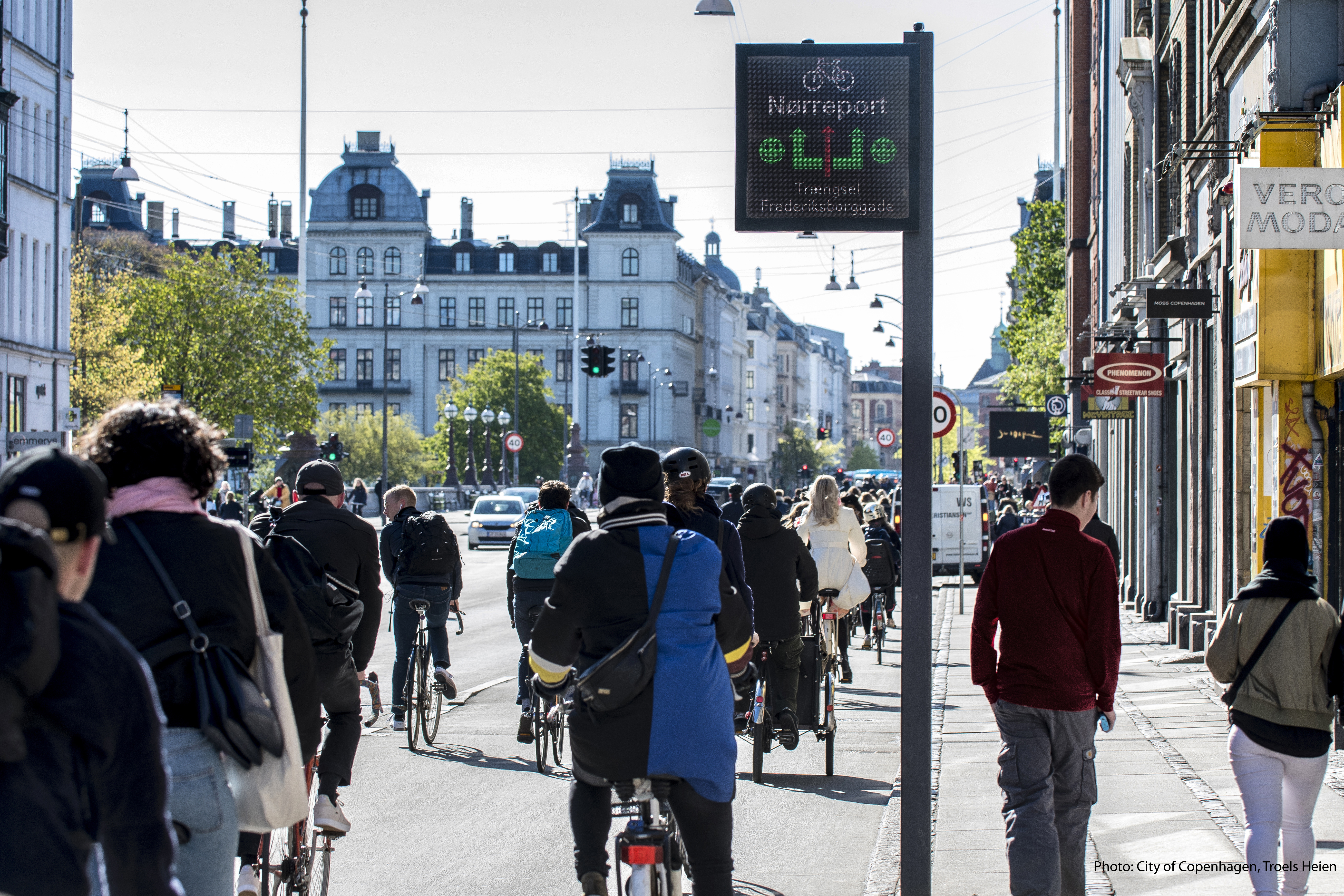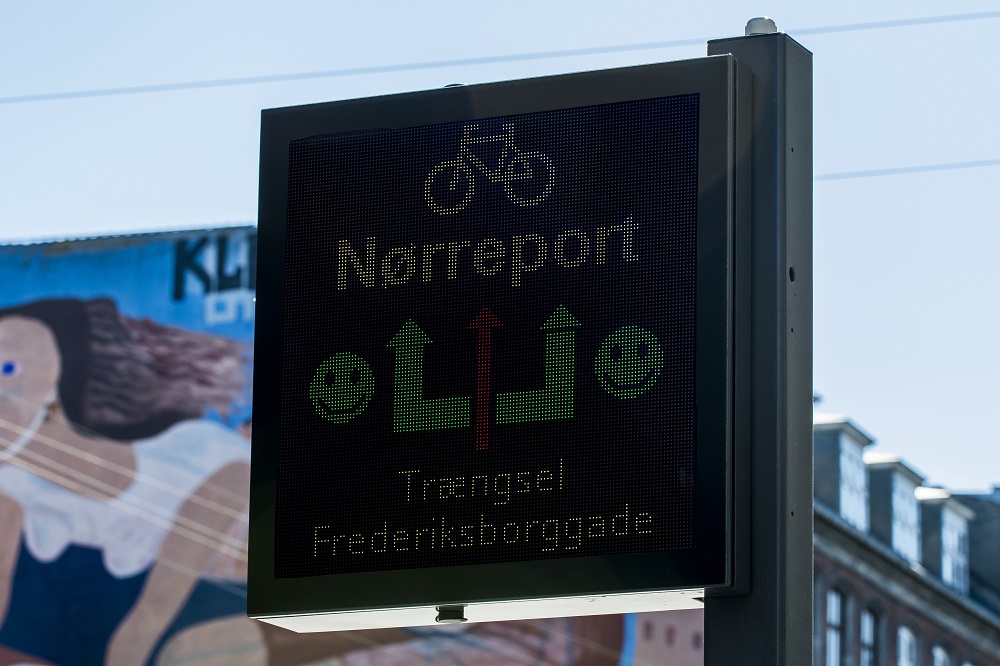
#VisionaryCities Series: The City of Copenhagen introduces variable message signs, exclusively for cyclists II
The #VisionaryCities Series is a collection of best practices and success stories from visionary local authority leaders who contribute to make Cycling in Europe better, safer and more common. We are going to be inviting some of them to share their thoughts and visions with ECF.com in the coming months.
 Jos van Vlerken is the ITS Project Manager for the City of Copenhagen. A year ago, he published an article for the Smarter Cycling Series about the deployment of the Variable Message Signs (VMS) for cyclists in Copenhagen as a way to give real-time feedback to cyclists about disruption on the road. The time has come to evaluate the system and plan its continuation.
Jos van Vlerken is the ITS Project Manager for the City of Copenhagen. A year ago, he published an article for the Smarter Cycling Series about the deployment of the Variable Message Signs (VMS) for cyclists in Copenhagen as a way to give real-time feedback to cyclists about disruption on the road. The time has come to evaluate the system and plan its continuation.
The large number of cyclists and the political will to advance cycling even further still drives innovation in Copenhagen towards an improved cycling infrastructure. To accommodate the large number of cyclists in the existing infrastructure in the City of Copenhagen has installed Variable Message Signs (VMS) exclusively for the use in bicycle traffic. The VMS for cyclists have been piloted in 2017, and if effective, they will disperse cyclist traffic through information about congestion and other incidents, thereby using the city’s cycling infrastructure more efficiently.The signs were evaluated using quantitative objective data for measuring the behavioural impact of the signs, as well as subjective questionnaires for measuring cyclist opinions of the signs.
Questionnaire Survey
45% of the cyclists surveyed believed that other cyclists around them were a major cause of nuisance and the biggest challenge for cyclists in traffic. This is a clear sign that bike lanes are getting crowded, even though Copenhagen has an extensive network of segregated mono-directional bike lanes that are between 2,5 and 4 meters wide.
With 62% of daily trips to work and education by citizens of the City of Copenhagen, it is no surprise that cyclists are aware of congestion on the bike lanes. The questionnaire has also shown that cyclists are willing to take a longer route, if the main route is congested. 28% of cyclists would take a route which is more than 900 meters longer to avoid congestion, while 27% state that they will take a 600 meter longer route. Only 11% of cyclists state that they are not willing to take a longer route to avoid congestion.
Behavioural measurement
To test the actual behaviour - that is, compliance with the warnings and suggestions - two routes were identified. The primary route was regularly congested in the morning and afternoon rush hours whereas the alternative one was a little longer (300 m) but had much wider bike lanes and less traffic. Three VMSs lead up to an intersection where cyclists could choose to take the primary or the alternative route. Tube-counting stations were set up on the two routes, and when a sensor detected congestion on the bike lane on the primary route, a warning was shown on the signs and a suggestion of alternative route was given.
A societal-economic analysis showed that there would be a good business case for the signs, if only 5% cyclists chose the alternative route when this was suggested.
Unfortunately, the tube counts which the measurements were to be based upon turned out to be highly inaccurate. For this reason, the results of the objective analysis were invalid. So, right now we do not know the actual effect of the VMS on the behaviour of the cyclists.
Unforeseen innovation
An unforeseen result of the exposed inaccuracy of the measuring equipment was that the City of Copenhagen, together with our main ITS supplier, began to explore alternative equipment for accurate cyclists count. With this purpose, we tested cameras and automatic image recognition software which showed to have a minimal accuracy of about 98%.
With regards to intelligent infrastructure technology, the City of Copenhagen has always strived to protect citizen privacy and anonymity. For this reason, the cameras are not used for surveillance and the feed is not stored but is only accessible for calibration purposes. The city traffic management system simply receives the counts as analysed by the on-location counting software connected to the cameras. In this way we attempt to gather data by systems that have built in safeguards.
This system even counts large crowds of cyclists accurately, which is a necessity for a cycling city like Copenhagen. The new bike counting cameras have since been deployed in 18 locations in Copenhagen and are used for daily traffic management as well as for evaluation and planning of signal changes, roadwork and more. The cameras will also enable the City of Copenhagen to repeat the behavioural evaluation of the variable message signs, to measure the effect and compliance of cyclists to the warnings and messages shown.
Conclusion and next steps
Although we do not yet know the full potential of the variable message signs for cyclists, we know from the questionnaires that the cyclists themselves appreciate the signs and find that they bring value to cycling. The signs also serve as a wake-up call for the infrastructure technology industry. Cycling is slowly but steadily advancing and re-establishing in cities across the world and we need intelligent solution for cycling which is comparable to the myriad of solutions and services that exist for motorized transport. Infrastructure technology needs to be developed for or adapted to the conditions and demands of cycling, such as lower speeds, as well as better visibility and manoeuvrability compared to cars. Then testing should be done rigorously, with regards to the actual effects of the solution, but also with regard to the subjective perception and attitude of cyclists towards the solution.
 The end-goal of this work should not be forgotten. The purpose of creating and improving cycling infrastructure is to make cycling more efficient, quicker, safer and a more reliable than other modes of transportation. Hereby creating a modal shift towards cycling which decreases emissions, improves health and road capacity, promotes social and gender equality in transportation, as well as increases overall quality of life in a city.
The end-goal of this work should not be forgotten. The purpose of creating and improving cycling infrastructure is to make cycling more efficient, quicker, safer and a more reliable than other modes of transportation. Hereby creating a modal shift towards cycling which decreases emissions, improves health and road capacity, promotes social and gender equality in transportation, as well as increases overall quality of life in a city.
But people will not bike out of altruism, not for prolonged periods in any case. Road authorities, transport planners and transport solution developers need to focus at least as much on creating efficient bicycle infrastructure as they do on creating infrastructure for motorised vehicles. In sustaining a bicycle culture, it is necessary to make cycling easier than the other modes. Taking the purchasing price, maintenance cost, operational and safety issues etc. of motorised private vehicles into account, cycling already has a head start. If infrastructure and intelligent solutions for cyclists were equally good as those for motorised vehicles, cycling would surely become the dominant mode of transportation.
News category:
Network/Project Involved:
Contact the author
Recent news!
Upcoming events
Contact Us
Avenue des Arts, 7-8
Postal address: Rue de la Charité, 22
1210 Brussels, Belgium









